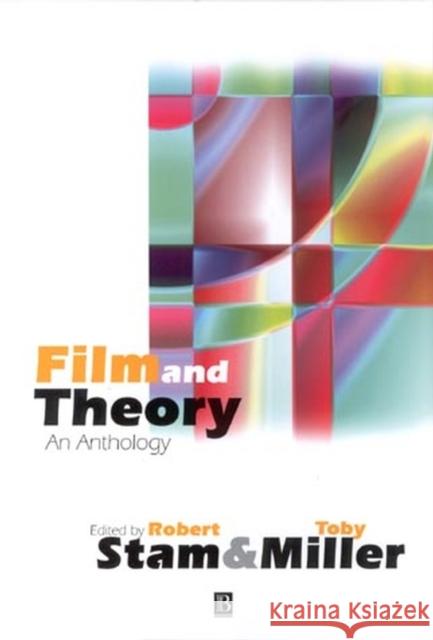Film and Theory: An Anthology » książka



Film and Theory: An Anthology
ISBN-13: 9780631206262 / Angielski / Miękka / 2000 / 882 str.
Film and Theory: An Anthology
ISBN-13: 9780631206262 / Angielski / Miękka / 2000 / 882 str.
(netto: 184,82 VAT: 5%)
Najniższa cena z 30 dni: 192,86
ok. 30 dni roboczych
Dostawa w 2026 r.
Darmowa dostawa!
Providing a collection of some of the most provocative and influential writings of film theory in the past thirty years, this anthology aims to provide a polylogue among theorists, deprovincializing the subject. "Film Theory" multiplies the perspectives and positions, the situations and locations, from which film theory is spoken.
Acknowledgments.
Introduction.
Part I: The Author:.
Introduction: Robert Stam.
1. Dennis Potter and the Question of the Television Author: Rosalind Coward.
2. To Desire Differently: Feminism and the French Cinema (extract): Sandy Flitterman–Lewis.
3. The Unauthorized Auteur Today: Dudley Andrew.
Part II: Film Language: Introduction: Robert Stam.
4. The Specificity of Media in the Arts: Noel Carroll.
5. For a Semio–Pragmatics of Film: Roger Odin.
6. The Scene of the Screen: Envisioning Cinematic and Electronic ′Presence′: Vivian Sobchack.
Part III: The Image and Technology:.
Introduction: Toby Miller.
7. Necessities and Constraints: A Pattern of Technological Change: Brian Winston.
8. Projections of Sound on Image: Michel Chion.
9. Modes of Production: The TV Apparatus: John T. Caldwell.
Part IV: Text and Intertext:.
Introduction: Robert Stam.
10. Questions of Genre: Steve Neale.
11. A Semantic/Syntactic Approach to Film Genre: Rick Altman.
12. The ′Force–Field′ of Melodrama: Stuart Cunningham.
13. Film Bodies: Gender, Genre and Excess: Linda Williams.
Part V: The Question of Realism:.
Introduction: Robert Stam.
14. The Cinema of Attraction: Early Film, Its Spectator and the Avant–Garde: Tom Gunning.
15. Classical Hollywood Cinema: Narrational Principles and Procedures: David Bordwell.
16. Black American Cinema: The New Realism: Manthia Diawara.
Part VI: Alternative Aesthetics:.
Introduction: Robert Stam.
17. Towards a Third Cinema: Notes and Experiences for the Development of Cinema of Liberation in the Third World: Fernando Solanas and Octavio Getino.
18. For an Imperfect Cinema: Julio Garcia Espinosa.
19. Towards a Critical Theory of Third World Films: Teshome H. Gabriel.
20. Rethinking Women′s Cinema: Aesthetics and Feminist Theory: Teresa de Lauretis.
Part VII: The Historical Spectator/Audience:.
Introduction: Toby Miller.
21. Cowboys and Indians: Perceptions of Western Films Among American Indians and Anglos: JoEllen Shively.
22. Television News and its Spectator: Robert Stam.
23. Addressing the Spectator of a ′Third World′ National Cinema: The Bombay ′Social′ Film of the 1940′s and 1950′s: Ravi S. Vasudevan.
Part VIII: Apparatus Theory:.
Introduction: Toby Miller.
24. The Imaginary Signifier: Christian Metz.
25. The Orthopsychic Subject: Film Theory and the Reception of Lacan: Joan Copjec.
26. Feminism, Film Theory, and the Bachelor Machines: Constance Penley.
Part IX: The Nature of the Gaze:.
Introduction: Toby Miller.
27. Visual Pleasure and Narrative Cinema: Laura Mulvey.
28. Film and the Masquerade: Theorizing the Female Spectator: Mary Ann Doane.
29. The Oppositional Gaze: bell hooks.
30. Looking Awry: Slavoj Zizek.
Part X: Class and the Culture Industries:.
Introduction: Toby Miller.
31. Constituents of a Theory of the Media: Hans Magnus Enzenburger.
32. Ideology, Economy and the British Cinema: John Hill.
33. Mass Culture and the Feminine: The ′Place′ of Television in Film Studies: Patrice Petro.
Part XI: Stars and Performance:.
Introduction: Toby Miller.
34. Introduction to Heavenly Bodies: Film Stars and Society: Richard Dyer.
35. Marlon Brando in ′On the Waterfront′: James Naremore.
36. Roseanne: Unruly Woman as Domestic Goddess: Kathleen K. Rowe.
37. The She–Man: Postmodern Bi–Sexed Performance in Film and Video: Chris Straayer.
Part XII: Permutations of Difference:.
Introduction: Robert Stam.
38. Gender and Culture of Empire: Towards a Feminist Ethnography of the Cinema: Ella Shohat.
39. Categories of Stereotyping of American Indians in Film: Ward Churchill.
40. Cultural Identity and Cinematic Representation: Stuart Hall.
41. White Privilege and Looking Relations: Jane Gaines.
42. White: Richard Dyer.
Part XIII: The Postmodern and the Global:.
Introduction: Robert Stam.
43. Television and Postmodernism: Jim Collins.
44 Critical and Textual Hypermasculinity: Lynne Joyrich.
45. Conclusion: Henry Jenkins.
Bibliography.
Index.
Toby Miller is a Professor in the Cinema Studies Department at New York University. He is the author of a wide range of work in cultural studies, including two recent books, Technologies of Truth (1998) and (with Alec McHoul) Popular Culture and Everyday Life (1998). He is also co–editor of the journal Social Text and with Robert Stam co–editor of The Blackwell Companion to Film Studies.
Robert Stam is a Professor in the Cinema Studies Department at New York University. His many books include Film Theory: An Introduction (Blackwell Publishers, 1999); Tropical Multiculturalism: A Comparative History of Race in Brazilian Cinema and Culture (1997); Unthinking Eurocentrism: Multiculturalism and the Media, with Ella Shohat (1994), which won the Katherine Singer Kovocs "Best Film Book Award"; and Subversive Pleasures: Bakhtin, Cultural Criticism, and Film (1992).
This anthology offers a collection of some of the most provocative and influential writings of film theory from the 1960s and 1970s, along with new directions from the last two decades. An introductory essay to the volume sums up developments in film theory from the beginning up through the 1980s, while introductions to specific groupings of essays summarize debates on those issues. Rather than look at film theory in terms of schools and allegiances, the editors investigate questions and problematics: What is the cinema? What is the cinematic apparatus? How do spectators differ in their desires? What is realism? Is realism desirable? Thus psychoanalysis, reception theory, cognitive theory, race theory, and feminism all provide partially valid answers to the question: What does the spectator want? This anthology′s goal is to facilitate a polylogue among the theorists who have ignored or maligned one another and to deprovincialize film theory. Film Theory multiplies the perspectives and positions, the situations and locations, from which film theory is spoken.
1997-2025 DolnySlask.com Agencja Internetowa
KrainaKsiazek.PL - Księgarnia Internetowa









